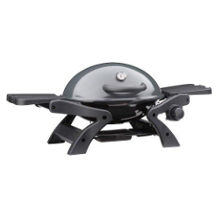Charcoal grill purchasing advice: how to choose the right product
- The most important facts in brief
- Charcoal grilling gives food an aroma that cannot be reproduced in the kitchen.
- Charcoal barbecues require neither electricity nor gas and are therefore flexible to use.
- Small tripod and kettle barbecues are well suited for the balcony or even the park.
- A large barbecue trolley offers every conceivable convenience and many preparation options.
Fire and flame for barbecuing
Is a perfect summer day possible without a barbecue? Many people would say no. 97 percent of Germans say they like to let meat, vegetables and other grilled food sizzle (source: Statista). Barbecuing is therefore a true national sport – no wonder, because it is sociable and appetising at the barbecue.
Barbecuing with charcoal is still by far the most popular method. 67 percent of barbecue masters in Germany fire their barbecue with this fuel (source: Statista). Electricity and gas are far behind, even though they are becoming increasingly popular. There is something primal about getting the charcoal to glow. Time must be taken for this, during which anticipation of the barbecue pleasure can arise. A charcoal grill reaches much higher temperatures than a pan on the cooker or an oven. At times, temperatures of up to 800 degrees Celsius can be reached. Many barbecue enthusiasts believe that the smoke from the charcoal gives the grilled food a distinctive flavour.
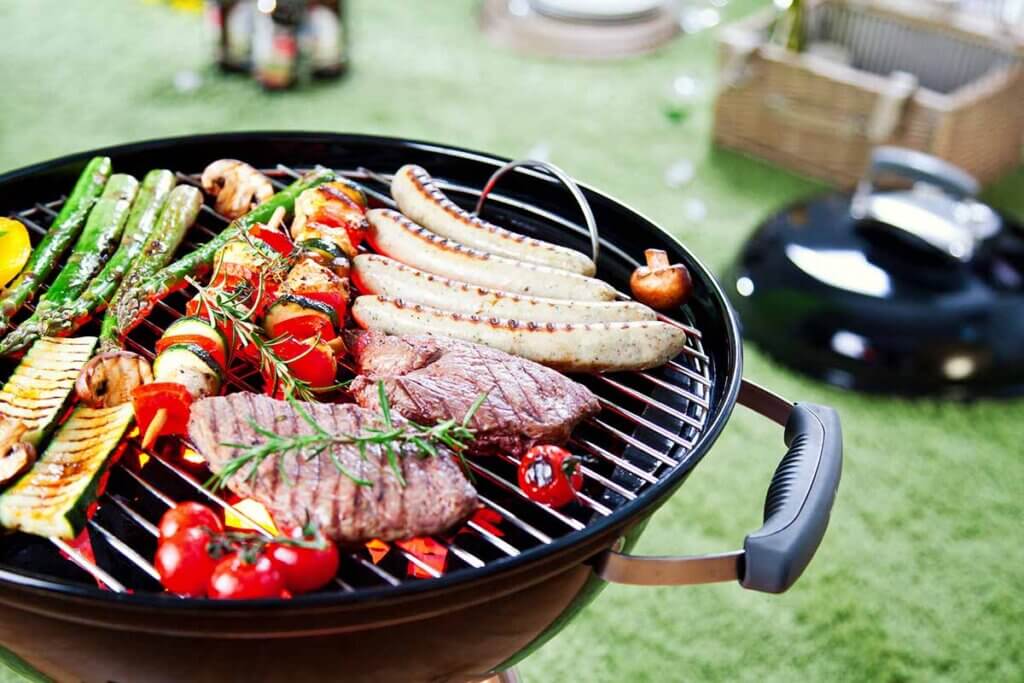
Which charcoal barbecues are available?
Charcoal barbecues must only be used outdoors, as harmful smoke is released when fat drips into the embers. Handling glowing coals indoors is also anything but advisable. The different barbecue models cater for different living situations. After all, not everyone has a large garden with a terrace. Small standing barbecues, kettle barbecues for example, are perfect for balconies.
Three-legged barbecue – flexible basic model
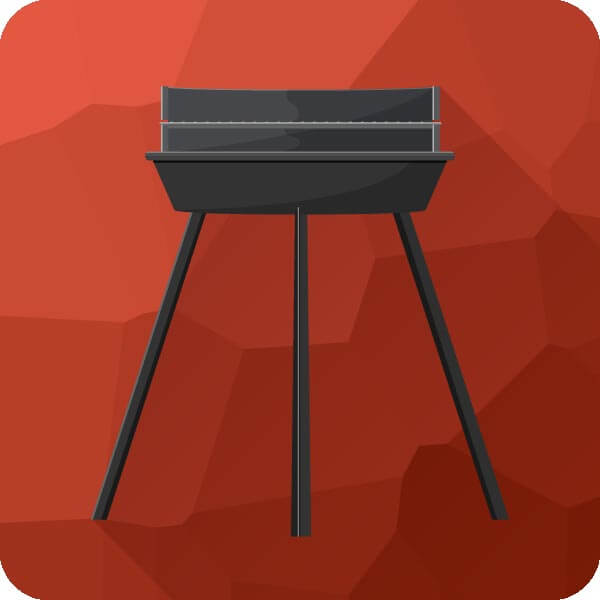
The three-legged grill is the simplest model among charcoal grills and at the same time a true classic. The simplest versions are simply a charcoal pan open at the top with three feet. Here, the food is cooked directly over the embers. The grill grate can usually be set at three different heights. In this way, the heat supply is regulated. The lightweight barbecue is easy to transport and set up, which is why it is a common sight in city parks and on festival grounds. However, grilling on such a model is not particularly comfortable. Due to its small dimensions, it also quickly reaches the end of its capacity for larger groups.
Column barbecue – quick heat-up

Column grills are characterised by the fact that the grill tray sits on a column, which in turn ends in a large stand. The column, which gives the grill its name, is hollow on the inside and thus always ensures a sufficient air supply. The so-called chimney effect is responsible for this. This allows air to flow from the bottom to the top. Column barbecues have ventilation slits or holes that allow the air supply to be regulated as required. This allows the charcoal to ignite much faster than on a simple three-legged grill, for example. As soon as the food is on the grill, the air supply can be turned down. Column grills with a funnel-shaped grill tray are particularly efficient. As the tray tapers downwards, less charcoal is needed to reach the same temperature as in a shallow grill pan.
Kettle grill – the all-rounder
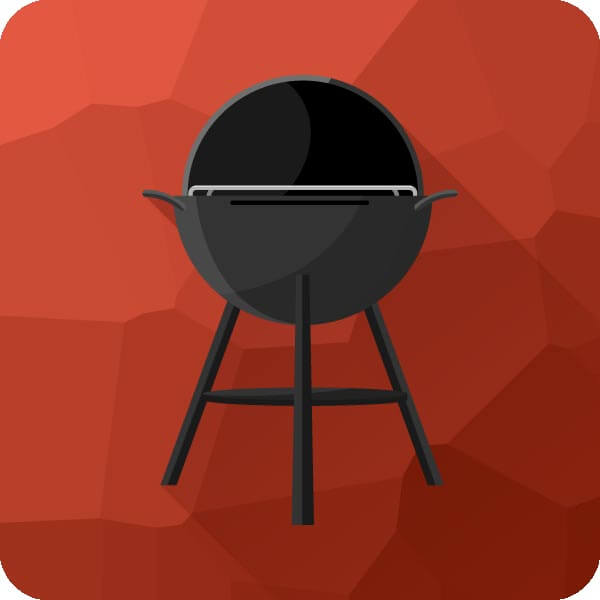
The kettle grill consists of two hemispheres: a domed charcoal pan and an equally domed lid. When the lid is in place, the characteristic spherical shape results. A kettle grill usually stands on three to four legs and sometimes has castors that allow it to be moved around more easily. The grill grate is inserted into the lower half of the kettle grill. Underneath the grate is a charcoal grate that collects charcoal and briquettes.
A good kettle grill has a cylinder with ventilation holes on its underside, through which the air supply is regulated. At the bottom of this cylinder, many models have a collecting tray that collects the ashes. When the lid is placed on the kettle grill, it functions like an oven. This allows indirect grilling, where the food is not directly above the embers. In addition, the lid protects both food and embers from wind and weather. Last but not least, it reduces the potential nuisance of smoke to the neighbours.
Smoker – for that BBQ feeling
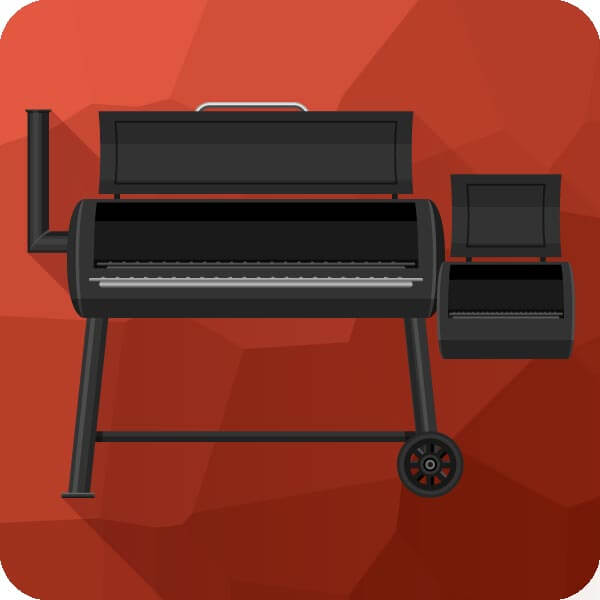
The smoker comes from the USA and is used for traditional barbecuing. With this type of barbecue, the food is not cooked directly over the embers, but indirectly in the hot smoke. Smokers therefore have a separate fire and cooking chamber. The smoke from the glowing charcoals passes from the fire chamber into the cooking chamber and is drawn off via a chimney pipe. As the two chambers are separate, no fat or meat juices can drip onto the coals.
If you want to prepare authentic spareribs, you need a smoker. For our domestic grilling habits, a conventional charcoal grill is more suitable. The long cooking times required for a good result with a smoker can also take some getting used to. Interested parties should also note that there are no small smoker versions. Such a grill is a large appliance in any case.
Barbecue trolley – the expert
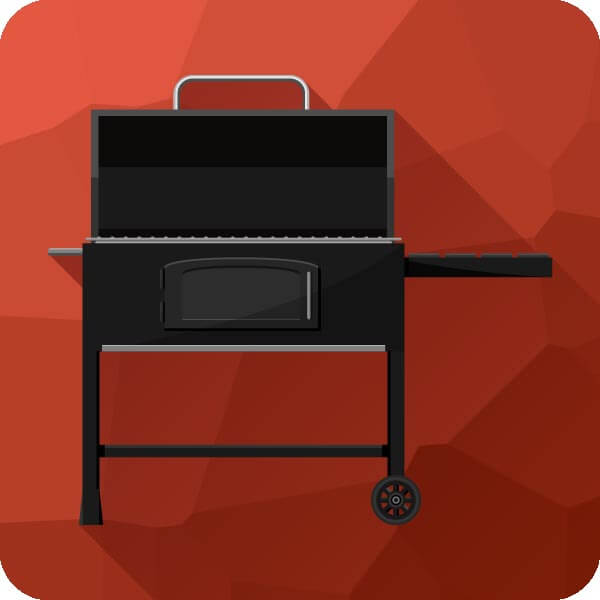
The barbecue trolley looks similar to a smoker. Most models are square grills with four legs and side-mounted wheels that allow the bulky cart to be pushed a few metres. Barbecue trolleys have a large grilling surface and side storage areas. This makes them ideal for catering for groups. In addition, there is storage space under the grill surface that can be used for necessary accessories. Some barbecue trolleys have a warming rack for temporary storage of barbecued food.
A large barbecue trolley needs space – not only at its place of use, but also in the garage or garden shed. Before buying, prospective buyers should determine whether there is enough space to store the barbecue. A less than optimal alternative is to leave the barbecue trolley outside under a special cover.
Swivel barbecue – for the nostalgic

A swivel barbecue exudes campfire romance and offers plenty of space for grilled food on its large, round grate. The most conventional version consists of three long metal rods that converge at their tips. From there, the grill hangs down on a chain. This chain can be used to raise or lower the grill. Turning the food on the grill requires some practice, as the grate swings back and forth. The embers are lit in a fire bowl, which belongs under the grate. Some modern swivel grills have only one curved bar and are therefore more space-saving. A swivel barbecue can only be set up if there is enough space. In case the fire bowl tips over, it is best to place the swivel barbecue on a terrace.
What to look for when buying a charcoal barbecue
Although there are many different versions of the charcoal barbecue, there are some general features that you should consider when making your purchase decision.
The size of the grilling surface
Several factors play a role in choosing the right grilling surface. One important question is how many people you want to serve. How much space is available in the garden or on the balcony is also important. Finally, the size should also be chosen depending on the food to be grilled. If you want to prepare special dishes such as leg of lamb, salmon or spare ribs, you need a sufficiently large grilling surface.
Even a small grill with a surface area of 1,000 to 1,500 square centimetres to fill a barbecue party of four people. To give you a better idea of size: classic three-legged barbecues usually have a diameter of about 35 centimetres. This corresponds roughly to an area of 960 square centimetres. Charcoal barbecues in this size range are light and mobile. They can be easily stowed in the car or even transported on a bicycle. Such designs are well suited for the balcony. Those who barbecue only occasionally and attach little importance to equipment extras will probably also be satisfied with such a model. Tripod and column barbecues usually fall into this size category. Ball grills are also often available in small sizes.
Barbecue ergonomics
Ergonomics do not only play a role in the office. Standing at the barbecue can also cause back pain. This is especially the case with tripod and swivel barbecues, where you often have to bend over to reach the grill grate. It is most comfortable if the grill grate is at hip height, as is the case with cooker tops.
A charcoal grill with a surface area of up to 2,500 square centimetres offers enough space for grilling food for six people. For round grills, this corresponds to a diameter of about 56 centimetres. A grill grate with these dimensions can also accommodate more unusual, large grilled food. Many kettle grills fall into this medium size category. Two common diameters for these grills are 47 and 57 centimetres or 1,735 and 2,550 square centimetres.
Barbecue fans will probably not be satisfied with small and medium-sized barbecues. Those who often receive many guests and experiment with new recipes will need a large grill with a surface area of around 3,000 square centimetres. A round grill grate with a diameter of 62 centimetres has roughly these dimensions. The expansive surface means a special degree of comfort. Large quantities of food can be placed next to each other on the grill and turned without getting in each other’s way. There is also enough space for various bowls. Barbecues with a surface area of 3,000 square centimetres and more usually have some special features such as side shelves, exchangeable grill plates and warming grates.
The material
Tripod and kettle barbecues are often made of sheet metal, as it is easy to bend into round shapes. The thicker it is, the more stable the barbecue. The sheet metal is in turn covered with a resistant and easy-to-clean powder coating. It can have different colours and provide a colourful accent in the garden or on the balcony. However, the coating is also a weak point. On lower-quality barbecues, it can easily flake off. If the damage is not repaired, the underlying material will sooner or later start to rust.
Higher-priced barbecues are often made of stainless steel. This material is long-lasting, stable and can easily withstand the heat of glowing charcoal. Stainless steel is rustproof and easy to clean, but the surface tends to yellow after a while. Stainless steel barbecues are relatively heavy and therefore usually remain in place. They are not suitable for trips to the park.
The barbecue grate
Many inexpensive barbecues have a chrome-plated steel grate. This serves its purpose, but is not particularly durable. The chrome coating can flake off over time. The exposed steel then begins to rust. Although rust is not harmful to health, it looks unsightly and can have a negative effect on the taste of the grilled food. Nickel, which is also present in the alloy along with chromium, is more of a concern, as some people are allergic to it.
A stainless steel grill is more expensive, but beats the chromium-plated grill in all respects. Stainless steel is non-allergenic, rust-free and does not affect the taste of food. The fact that stainless steel is not a good conductor of heat has advantages and disadvantages. It does not absorb heat very well and therefore does not give it off very well. A grill grate made of stainless steel therefore heats up more slowly than one made of cast iron. For barbecue masters who don’t consider themselves experts, this can be an advantage: they don’t have to be afraid that the food will burn directly. A stainless steel grill is easy to clean; conventional cleaning agent and a brush are sufficient. When cleaning, users do not have to worry about damaging a coating.
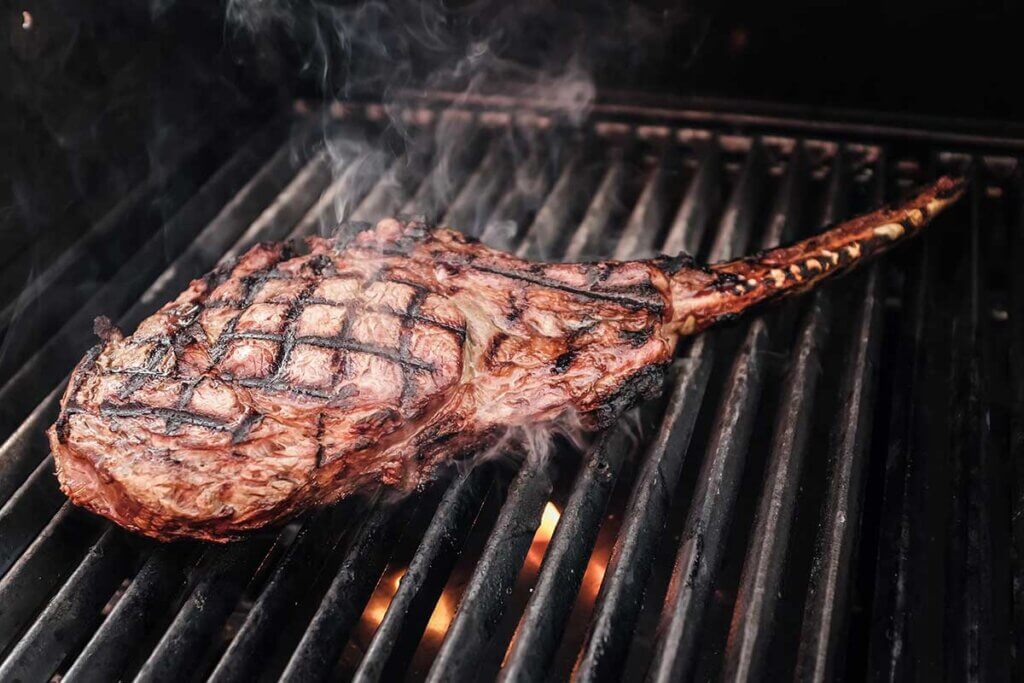
Cast iron grills are popular with professionals. This is because cast iron is a very good conductor of heat, unlike stainless steel. The cast iron bars can store heat better and release it for longer. Grilled food that is roasted on such a grate gets a distinct roasted aroma and the so-called “branding”. This refers to the dark stripes that are characteristic of steaks, for example.
Temperature regulation
The easiest way to regulate the temperature is to hang the grill grate higher or lower. This means that the embers are not affected. With tripod and swivel grills, this is often the only way to change the temperature. The regulation of the temperature on column grills is somewhat more sophisticated. More or less air is supplied to the coals via a ventilation slider. The more air the embers get, the hotter they get.
On kettle grills, the ventilation slits on the underside of the grill pan regulate the supply air, while the slits in the lid regulate the exhaust air. Oxygen reaches the coals through the lower vents. So when the sliders are wide open, the embers get plenty of oxygen and the temperature rises. Smoke and heat escape through the slits in the lid. If they are only opened slightly, the kettle grill can be used as a smoker. If the slots are opened both at the top and at the bottom, a chimney effect occurs and the embers get plenty of oxygen.
Many grills with lids have a thermometer built into them. Since it is often not located near the grill grate, the temperature displayed deviates somewhat. For the preparation of most dishes, this is not decisive. However, if you are preparing “low-and-slow” dishes such as spare ribs or pulled pork, you need to know exactly how hot it is inside the grill. A separate barbecue thermometer is ideal for this.
Frequently asked questions about grilling with charcoal
The time to fire up the barbecue must be chosen wisely. If you take too long, you will quickly be confronted with the impatience of hungry guests. Unfortunately, lighting charcoal and briquettes has its pitfalls. Which method promises success and what actually distinguishes charcoal from briquettes?
How is charcoal lit?
Getting charcoal to glow can always be a challenge, especially with barbecues that do not support users in the process. A common method for simple three-legged barbecues is to stack the coals or briquettes in a pyramid shape over a lighting cube and then ignite it with a safety lighter. However, these cubes contain chemicals. It is therefore important to allow the charcoal to glow properly before placing the food on the grill. An alternative is, for example, to put several egg cartons inside each other and stack the coals there.
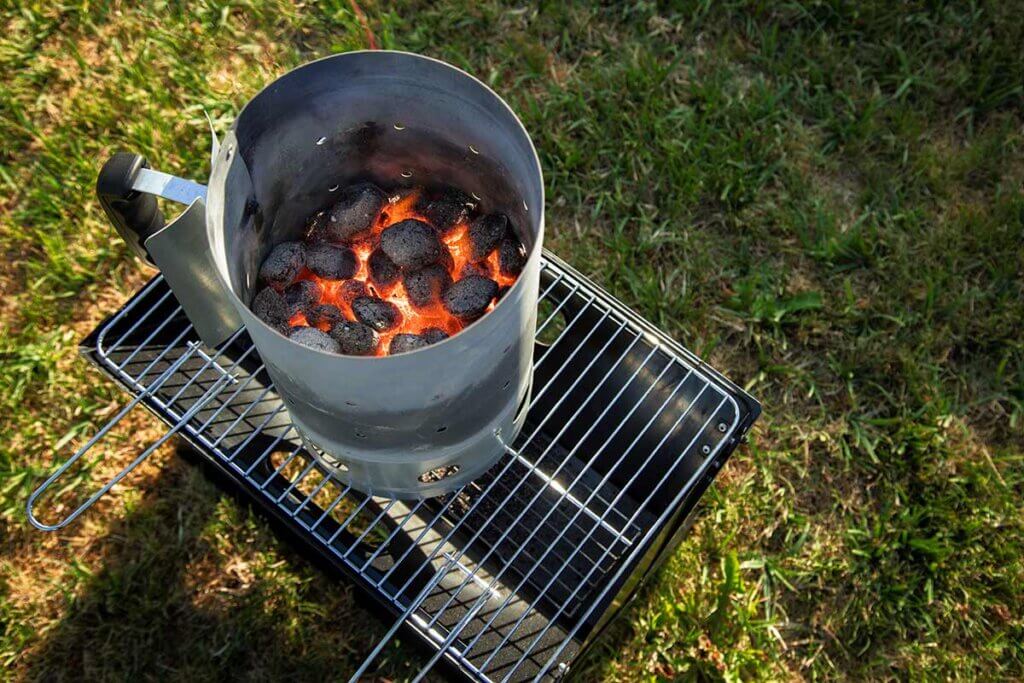
Many barbecue enthusiasts swear by the lighting chimney as a reliable helper. The cylindrical chimney is filled with coals or briquettes and placed over lighters that are placed in the grill pan. Due to the chimney effect, the coals glow quickly. Be a little careful when transferring the fuel. Wear work gloves to be on the safe side.
With good charcoal grills, the air circulation is so sophisticated that the fuel can be made to glow directly in the grill with little effort.
What do I need to consider when buying charcoal?
There are two aspects to consider when buying charcoal: Ingredients and origin. As far as ingredients are concerned, consumers can look for the DIN test mark, which guarantees that the charcoal does not contain pitch, petroleum, coke or plastic. Good charcoal consists exclusively of hard hardwood, for example beech wood.
Consumers have a harder time with regard to the origin, because there is no labelling obligation here. No one wants to use charcoal made from tropical wood, which is sometimes illegally felled, on their barbecue. Stiftung Warentest also criticises the lack of transparency on the part of manufacturers. Of 17 charcoal bags tested, only nine provided information on the origin of the charcoal. Tropical wood was found in five samples. One particularly brazen producer even labelled its charcoal as sustainable and coming from domestic forests, although it contained tropical wood. Consumers must therefore be particularly careful when buying charcoal. One of the last companies in Germany to industrially produce charcoal from native trees is Profagus from near Göttingen. This charcoal is not only ecological, but also regularly scores well in tests.
What is the difference between charcoal and briquettes?
Anyone who wants to fire up the barbecue is often faced with the choice between classic coals and briquettes. The latter are made by pressing coal dust and small pieces of coal into shape under high pressure. Since briquettes are more evenly shaped than coals, they are easier to spread on the grill. The advantage of this is that the heat is evenly distributed to the food. If the coals are of different sizes, it can happen that it is significantly hotter in some places than in others. Briquettes glow about three times as long as coals and are therefore better suited for a long barbecue. It can take twice as long to light them – unless you use a fireplace. Many barbecue experts are of the opinion that briquettes only impart a weak charcoal aroma to the barbecued food.

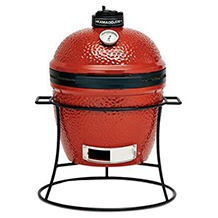
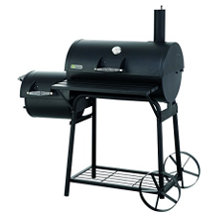
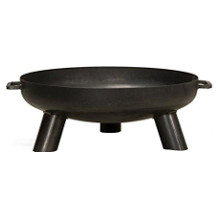
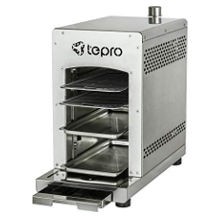
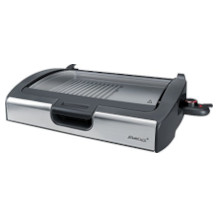
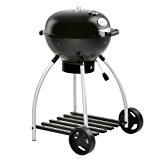
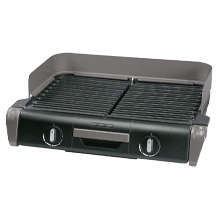
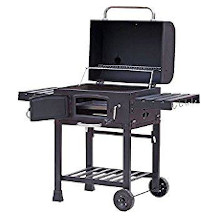
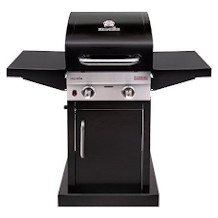

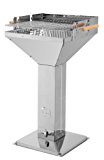
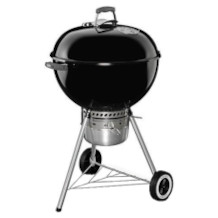
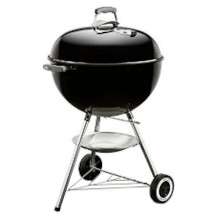
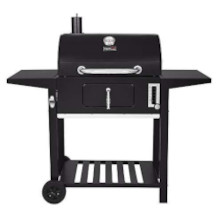

 1,014 reviews
1,014 reviews
